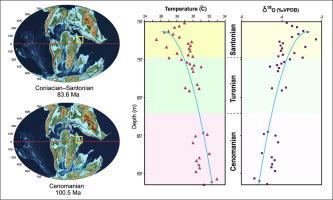当前位置:
X-MOL 学术
›
Gondwana Res.
›
论文详情
Our official English website, www.x-mol.net, welcomes your feedback! (Note: you will need to create a separate account there.)
Paleoclimate changes across the Cenomanian–Santonian transition at the southern Neo-Tethys margin (SW Iran): An integrated approach
Gondwana Research ( IF 6.1 ) Pub Date : 2024-03-25 , DOI: 10.1016/j.gr.2024.02.013 Aziz Abdolahi , Mohammad Bahrehvar , Hamzeh Mehrabi , Mahboobeh Omidvar , Ali Kadkhodaie , David A. Wood
Gondwana Research ( IF 6.1 ) Pub Date : 2024-03-25 , DOI: 10.1016/j.gr.2024.02.013 Aziz Abdolahi , Mohammad Bahrehvar , Hamzeh Mehrabi , Mahboobeh Omidvar , Ali Kadkhodaie , David A. Wood

|
The Cenomanian–Santonian (C–S) carbonate successions include valuable petroleum reservoirs in the Zagros Basin. They also provide important information on the paleogeographic setting, paleoclimatic conditions, and tectonic evolution of the southern Neo-Tethys margin. This study focuses on the paleoclimatic changes across the C–S transition using the petrographical, petrophysical, paleontological, major and trace element and isotope geochemical data from three subsurface sections selected from the southern Dezful Embayment and northwestern part of the Persian Gulf. Remarkable differences in allochemical (skeletal and non-skeletal) elements indicate dissimilar paleoclimatic conditions during the Cenomanian–Turonian and Santonian. Paleoexposure events are related to diagenetic processes such as extensive meteoric dissolution (karstification) and the development of bauxitic–lateritic paleosols with high Fe, Al, and kaolinite concentrations indicating warm and humid (tropical) conditions. Increased values of Fe, Al, Rb, and Sr/Sr isotopic ratios and depletion of Ca, Sr, δO, and δC considered together indicate meteoric diagenetic effects under this paleoclimatic condition. Spectral gamma measurements are used to investigate paleoclimatic conditions. Low content of Uranium (U) throughout the transgressive systems tract (TST) and high concentration in the regressive systems tract (RST) along with low contents of kaolinite within the Santonian sequence denote the predominance of arid conditions. The major fall in U concentrations at the Cenomanian–Turonian interface (CT-Exposure Surface) could be regarded as an outcome of the fall in the relative sea-level and a proxy of oxidizing conditions (Th/U > 7) that could be the consequence of a change in paleoclimate from humid/semi-humid to humid. Evidence for a 3–4 °C decrease in paleo-temperature and increase in aridity are recorded during the Cenomanian–Santonian transition in the Zagros Basin, which is in close agreement with global trends. This cooling pattern is attributed to a decline in atmospheric CO levels and alterations in oceanic circulation, specifically an increase in meridional circulation.
中文翻译:

新特提斯山脉南部边缘(伊朗西南部)塞诺曼阶-桑托阶过渡期间的古气候变化:综合方法
塞诺曼阶-桑托阶 (C-S) 碳酸盐岩层系包括扎格罗斯盆地有价值的石油储层。它们还提供了有关新特提斯洋边缘南部的古地理环境、古气候条件和构造演化的重要信息。本研究利用取自迪兹富尔湾南部和波斯湾西北部的三个地下剖面的岩石学、岩石物理、古生物学、常量和微量元素以及同位素地球化学数据,重点研究 C-S 转变过程中的古气候变化。同质化学(骨骼和非骨骼)元素的显着差异表明塞诺曼期-土伦期和桑托尼期的古气候条件不同。古暴露事件与成岩过程有关,例如广泛的陨石溶解(岩溶作用)以及铁、铝和高岭石浓度高的铝土矿-红土古土壤的发育,表明温暖和潮湿(热带)条件。 Fe、Al、Rb 和 Sr/Sr 同位素比值的增加以及 Ca、Sr、δ18O 和 δ13C 的消耗一起考虑表明了这种古气候条件下的大气成岩作用。光谱伽马测量用于研究古气候条件。整个海侵体系域 (TST) 中铀 (U) 含量较低,海退体系域 (RST) 中铀 (U) 含量较高,以及桑托尼亚层序中高岭石含量较低,表明干旱条件占主导地位。塞诺曼阶-土仑阶界面(CT-暴露表面)U浓度的大幅下降可以被视为相对海平面下降的结果,也是氧化条件(Th/U > 7)的代表,这可能是古气候从潮湿/半湿润到潮湿变化的结果。在扎格罗斯盆地的塞诺曼阶-桑托阶阶过渡期间,记录了古气温下降 3-4 °C 和干旱增加的证据,这与全球趋势非常一致。这种冷却模式归因于大气二氧化碳水平的下降和海洋环流的变化,特别是经向环流的增加。
更新日期:2024-03-25
中文翻译:

新特提斯山脉南部边缘(伊朗西南部)塞诺曼阶-桑托阶过渡期间的古气候变化:综合方法
塞诺曼阶-桑托阶 (C-S) 碳酸盐岩层系包括扎格罗斯盆地有价值的石油储层。它们还提供了有关新特提斯洋边缘南部的古地理环境、古气候条件和构造演化的重要信息。本研究利用取自迪兹富尔湾南部和波斯湾西北部的三个地下剖面的岩石学、岩石物理、古生物学、常量和微量元素以及同位素地球化学数据,重点研究 C-S 转变过程中的古气候变化。同质化学(骨骼和非骨骼)元素的显着差异表明塞诺曼期-土伦期和桑托尼期的古气候条件不同。古暴露事件与成岩过程有关,例如广泛的陨石溶解(岩溶作用)以及铁、铝和高岭石浓度高的铝土矿-红土古土壤的发育,表明温暖和潮湿(热带)条件。 Fe、Al、Rb 和 Sr/Sr 同位素比值的增加以及 Ca、Sr、δ18O 和 δ13C 的消耗一起考虑表明了这种古气候条件下的大气成岩作用。光谱伽马测量用于研究古气候条件。整个海侵体系域 (TST) 中铀 (U) 含量较低,海退体系域 (RST) 中铀 (U) 含量较高,以及桑托尼亚层序中高岭石含量较低,表明干旱条件占主导地位。塞诺曼阶-土仑阶界面(CT-暴露表面)U浓度的大幅下降可以被视为相对海平面下降的结果,也是氧化条件(Th/U > 7)的代表,这可能是古气候从潮湿/半湿润到潮湿变化的结果。在扎格罗斯盆地的塞诺曼阶-桑托阶阶过渡期间,记录了古气温下降 3-4 °C 和干旱增加的证据,这与全球趋势非常一致。这种冷却模式归因于大气二氧化碳水平的下降和海洋环流的变化,特别是经向环流的增加。



























 京公网安备 11010802027423号
京公网安备 11010802027423号